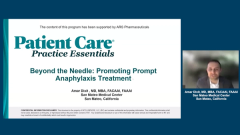
Challenges with Epinephrine Autoinjectors
A panelist discusses how current guidance has evolved to no longer require emergency department visits for all epinephrine uses, particularly when patients experience prompt and complete resolution of symptoms after administration.
Episodes in this series

Video content above is prompted by the following:
Dixit reflects on traditional epinephrine administration methods, explaining that clinicians have historically used both vial/syringe and autoinjector approaches interchangeably with generally consistent results. However, multiple challenges persist with autoinjectors: needle phobia, patient uncertainty about proper use, stigma concerns (particularly among younger patients), temperature storage requirements, short shelf life (often 7-9 months by time of patient receipt), and bulky design that discourages consistent carrying.
A polling question reveals that 14 out of 15 attending clinicians report patients very often or occasionally express concerns about using epinephrine autoinjectors. Dixit summarizes the 5 key unmet needs: fear of use, failure to carry devices consistently, inadequate knowledge of proper administration technique, storage and shelf life challenges, and uncertainty about when administration is appropriate. These barriers significantly reduce the likelihood that patients will receive timely epinephrine during anaphylactic emergencies.
Dixit addresses an audience question about biphasic reactions, clarifying that patients experiencing symptom recurrence after initial epinephrine treatment should always go to the emergency department. He emphasizes that the updated guidance allowing patients to avoid emergency care only applies when reactions weren’t severely threatening, fully resolved with 1 epinephrine dose, and showed complete resolution without return of symptoms. He maintains that when in doubt, activating EMS or seeking emergency care remains the safest approach.
Newsletter
Enhance your clinical practice with the Patient Care newsletter, offering the latest evidence-based guidelines, diagnostic insights, and treatment strategies for primary care physicians.














































































































































































































































































